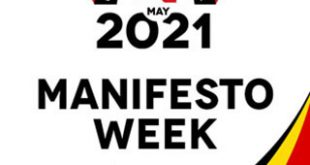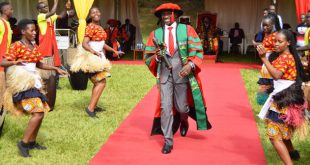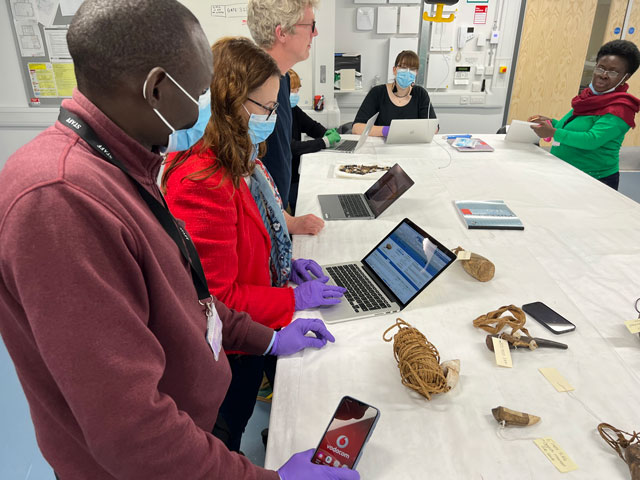
Three experts in Cambridge to secure Ugandan historic artefacts
Cambridgeshire, England | LOUIS JADWONG & AGENCIES | Ugandan charms (Mayembe) and traditonal wear (Kanzu) are among the items a team of experts visiting the University of Cambridge Museum of Archaeology and Anthropology (MAA) in England have identified. They will be listed for repatriation to Kampala next year.
Uganda’s Commissioner for Monuments and Museums Rose Mwanja Nkaale, and the Curator, Nelson Abiti, together with Derek Peterson, a professor of History and African Studies at the University of Michigan, are currently in Cambridgeshire going through the MAA collection to identify objects they will prioritize for repatriation.
This is the first stage in a new project dubbed “Repositioning the Uganda Museum” aimed at securing the repatriation of historically and culturally important objects, from Cambridge, to Uganda’s museum in Kampala.
Today colleagues from @ugandamuseums & I took the first steps in 'Repositioning the Uganda Museum', which will support the repatriation of cultural objects from @MAACambridge to the Uganda Museum.
Today we examined mayembe–'charms'–acquired by the Museum in the early c20th. 1/ pic.twitter.com/ND63BDWLYt
— Derek R Peterson (@Unseen_Archive) November 7, 2022
This project was recently awarded a $100,000 (Sh356millin) grant from The Andrew W. Mellon Foundation based in the US. The key aim of the project is to repatriate several dozen artefacts, a small subset of the hundreds of thousands of objects taken from Africa in the colonial era.
“We are presently going through the MAA collection, and Nelson and Rose are beginning to identify objects that they’d want to prioritize for repatriation. Once they have a list, we will begin working with colleagues in Cambridge on the mechanics of returning these materials to Uganda,” said Professor Derek Peterson in a message early today.
Prof. Peterson added that “the hope is to have the objects in Uganda in 2023, after which we’ll conduct research with Ugandan families and professionals about their history and background. All of this will lead to a special exhibition, in Kampala, in 2024, where we’ll showcase these objects and tell their story fully.”
Today was the third day of the ongoing investigation into the Uganda collections at @MAACambridge, generously supported by @MellonFdn.
Here are a few of the fascinating objects we examined. First: a kanzu from Buganda, dating to 1903, linen with hand-stitched adornments. pic.twitter.com/1BqsPlfE0O
— Derek R Peterson (@Unseen_Archive) November 9, 2022
“These objects have been dislocated both in space and in time,” said Peterson earlier on the University of Michigan website. “Colonial-era collectors took them out of Ugandans’ hands and made them into specimens of ethnic identity. We want to put them back into the hands of the people who made them meaningful, to open up dialogues about the onward course of families, clans, and professions.”
According to the Michigan University website, the items were collected and donated to MAA by the late British anthropologist and missionary Rev John Roscoe.
Roscoe (1861–1932) was a missionary from the Anglican Missionary Society to East Africa.
Today–our 2nd day in the stores @MAACambridge–colleagues from @ugandamuseums & I examined objects from the early c20th: beautifully inscribed pots from Ankole, a remarkable drum from Bunyoro, a headdress from Bugisu.
Our work launches a collaboration funded by @MellonFdn to 1/ pic.twitter.com/b9pbNKtKoB
— Derek R Peterson (@Unseen_Archive) November 8, 2022
The Cambridge museum is said to hold around 1,400 separate ethnographic objects from Uganda, many of them acquired by Roscoe. Others were donated by Buganda Kingdom’s then Katikkiro (prime minister), Sir Apolo Kaggwa (1890-1926). Most of Roscoe’s collection has not been displayed in Cambridge
Describing how the items ended up in England, writer Gregory Parker on the Michigan website states that, “In the late-nineteenth century, British missionary John Roscoe was in the Kingdom of Buganda—part of present-day Uganda— collecting ethnographic objects and operating partly under the direction of the MAA. At that time, the kingdom was in turmoil, suffering a series of religious wars and increased interference from the Imperial British East Africa Company (Buganda became part of the British Empire in 1900). ”
“It was a time of massive political and social transformation. As Protestant Christians gained power, non-Christian practitioners of the old religion were eager to shed any symbol of their prior beliefs. In other words, Roscoe built his collection at a time when the instruments of the old way of life were dramatically devalued.”
Who is Prof. Peterson?
Peterson first lived in Kenya in the 1990s, and first came to Uganda in 2003 when he started doing some research on the history of the balokole (the Tukutendereza movement of the 1930s and 40s).
Asked what drove him to like working on Ugandan issues, he said, “I loved being in Kenya. But I felt as though there was more scope for historical work in Uganda.”
He revealed that he soon found colleagues and partners in Uganda with shared interest in history and African studies.
“I first started working on archive conservation in Uganda in 2008, when colleagues from Mountains of the Moon University and I started a project to organize and digitise the local government archives in Kabarole. Once I got involved in that sort of work there was no turning back.”
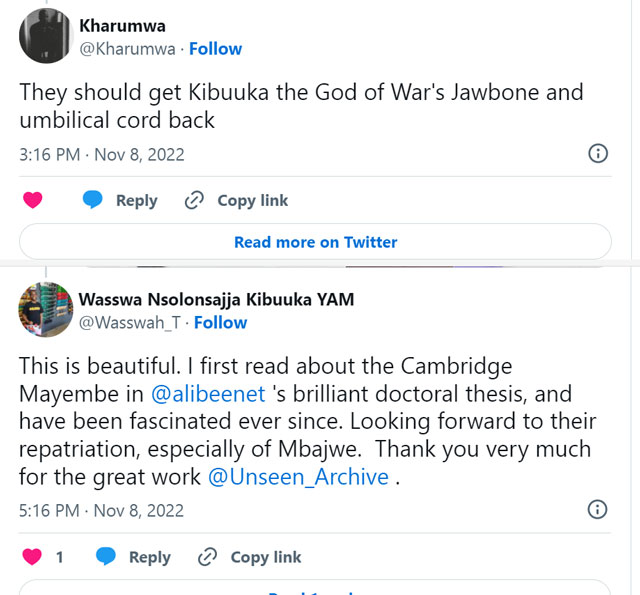
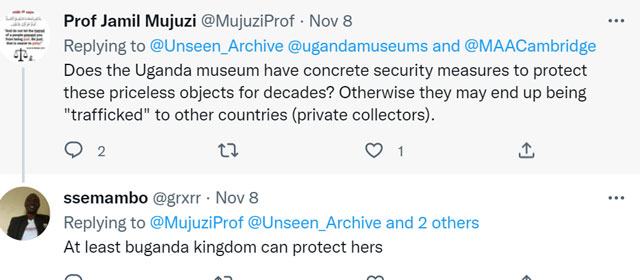
 The Independent Uganda: You get the Truth we Pay the Price
The Independent Uganda: You get the Truth we Pay the Price
